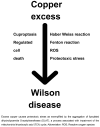Wilson Disease: Copper-Mediated Cuproptosis, Iron-Related Ferroptosis, and Clinical Highlights, with Comprehensive and Critical Analysis Update
- PMID: 38731973
- PMCID: PMC11084815
- DOI: 10.3390/ijms25094753
Wilson Disease: Copper-Mediated Cuproptosis, Iron-Related Ferroptosis, and Clinical Highlights, with Comprehensive and Critical Analysis Update
Abstract
Wilson disease is a genetic disorder of the liver characterized by excess accumulation of copper, which is found ubiquitously on earth and normally enters the human body in small amounts via the food chain. Many interesting disease details were published on the mechanistic steps, such as the generation of reactive oxygen species (ROS) and cuproptosis causing a copper dependent cell death. In the liver of patients with Wilson disease, also, increased iron deposits were found that may lead to iron-related ferroptosis responsible for phospholipid peroxidation within membranes of subcellular organelles. All topics are covered in this review article, in addition to the diagnostic and therapeutic issues of Wilson disease. Excess Cu2+ primarily leads to the generation of reactive oxygen species (ROS), as evidenced by early experimental studies exemplified with the detection of hydroxyl radical formation using the electron spin resonance (ESR) spin-trapping method. The generation of ROS products follows the principles of the Haber-Weiss reaction and the subsequent Fenton reaction leading to copper-related cuproptosis, and is thereby closely connected with ROS. Copper accumulation in the liver is due to impaired biliary excretion of copper caused by the inheritable malfunctioning or missing ATP7B protein. As a result, disturbed cellular homeostasis of copper prevails within the liver. Released from the liver cells due to limited storage capacity, the toxic copper enters the circulation and arrives at other organs, causing local accumulation and cell injury. This explains why copper injures not only the liver, but also the brain, kidneys, eyes, heart, muscles, and bones, explaining the multifaceted clinical features of Wilson disease. Among these are depression, psychosis, dysarthria, ataxia, writing problems, dysphagia, renal tubular dysfunction, Kayser-Fleischer corneal rings, cardiomyopathy, cardiac arrhythmias, rhabdomyolysis, osteoporosis, osteomalacia, arthritis, and arthralgia. In addition, Coombs-negative hemolytic anemia is a key feature of Wilson disease with undetectable serum haptoglobin. The modified Leipzig Scoring System helps diagnose Wilson disease. Patients with Wilson disease are well-treated first-line with copper chelators like D-penicillamine that facilitate the removal of circulating copper bound to albumin and increase in urinary copper excretion. Early chelation therapy improves prognosis. Liver transplantation is an option viewed as ultima ratio in end-stage liver disease with untreatable complications or acute liver failure. Liver transplantation finally may thus be a life-saving approach and curative treatment of the disease by replacing the hepatic gene mutation. In conclusion, Wilson disease is a multifaceted genetic disease representing a molecular and clinical challenge.
Keywords: Fenton reaction; Haber–Weiss reaction; Wilson disease; copper overload; cuproptosis; family screening; ferroptosis; genetic testing; reactive oxygen species (ROS).
Conflict of interest statement
The authors declare no conflicts of interest.
Figures
References
-
- Cowan J.J., Thielemann F.K. R-process nucleosynthesis in Supernovae. Phys. Today. 2004;57:47–53. doi: 10.1063/1.1825268. - DOI
-
- Burbidge E.M., Burbidge G.R., Fowler W.A., Hoyle F. Synthesis of the elements in stars. Rev. Mod. Phys. 1957;29:547–650. doi: 10.1103/RevModPhys.29.547. - DOI
-
- Frebel A., Beers T.C. Some of the universe’s heavier elements are created by neutron star collisions. Phys. Today. 2018;71:30–37. doi: 10.1063/PT.3.3815. - DOI
Publication types
MeSH terms
Substances
LinkOut - more resources
Full Text Sources
Medical
Research Materials
Miscellaneous


